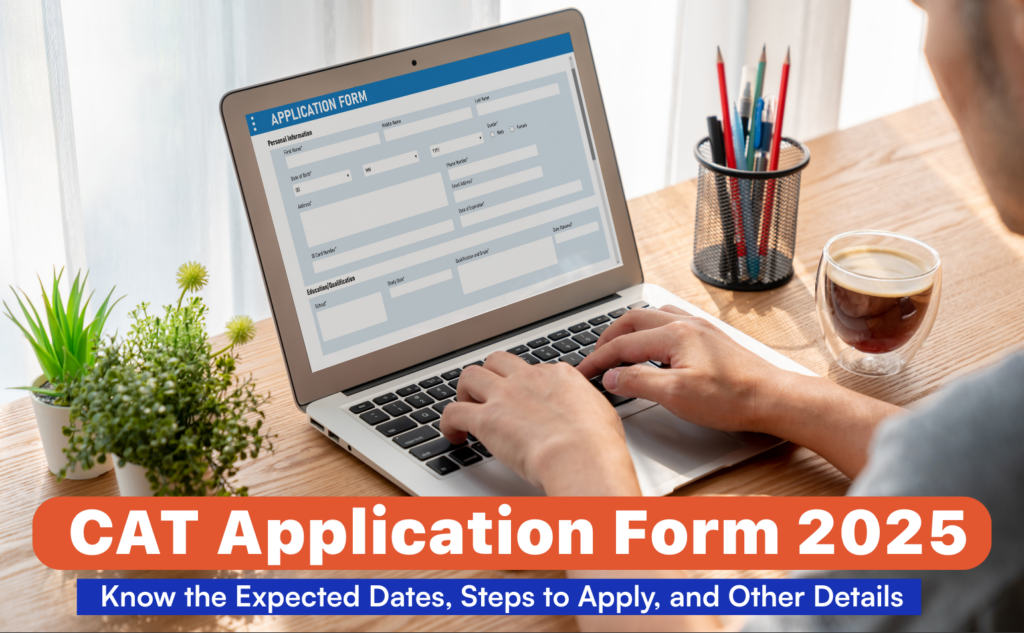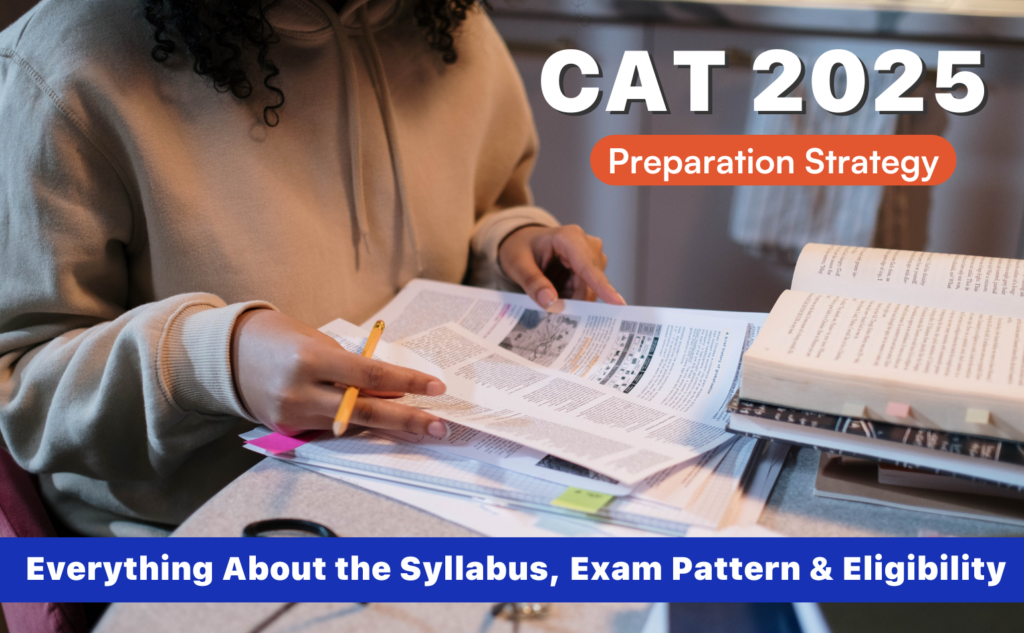To ace CAT, understanding the syllabus thoroughly is crucial. While the official CAT syllabus is not explicitly defined by IIMs, an analysis of papers from previous years reveals a consistent pattern in the topics tested.
Key Highlights of CAT 2025 Syllabus:
- The exam consists of three sections:
- Verbal Ability & Reading Comprehension (VARC)
- Data Interpretation & Logical Reasoning (DILR)
- Quantitative Aptitude (QA)
- Each section has a time limit of 40 minutes (total 120 minutes).
- The syllabus is vast, covering reading comprehension, logical reasoning, data interpretation, arithmetic, algebra, and geometry.
This article will provide an in-depth breakdown of the CAT 2025 syllabus, covering important topics in each section, recommended preparation strategies, and essential study materials.
CAT 2025 Exam Structure & Pattern
Before diving into the syllabus, it’s essential to understand the exam structure. The CAT 2025 paper pattern is expected to remain the same as in recent years.
CAT 2025 Exam Overview
| Particulars | Details |
| Exam Mode | Computer-Based Test (CBT) |
| Expected Exam Date | 23rd November 2025 |
| Conducting Body | IIM Kozhikode |
| Number of Sections | Three – VARC, DILR, and QA |
| CAT Exam Slots | The Exam is conducted in 3 Slots:Slot 1 – 8:30 AM to 10:30 AMSlot 2 – 12:30 PM to 2:30 PMSlot 3 – 4:30 PM to 6:30 PM |
| No. of Questions | 68 |
| CAT Total Marks | 204 |
| Total Duration | 120 minutes (2 hours) |
| Language of Question Paper | English |
| Number of Answer Choices | 4 |
| Question Type | Multiple Choice Questions (MCQs) & Type in The Answer (TITA) |
| Sectional Time Limit | 40 minutes per section |
| Marking Scheme | +3 Marks for right answer-1 Mark for every wrong answerNo negative marking for TITA |
| Scoring System | Percentile-based ranking |
CAT 2025 Section-Wise Question Distribution (Expected)
| Section | Expected No. of Questions | Time Allotted |
| Verbal Ability & Reading Comprehension (VARC) | 24 | 40 minutes |
| Data Interpretation & Logical Reasoning (DILR) | 22 | 40 minutes |
| Quantitative Aptitude (QA) | 22 | 40 minutes |
Candidates cannot switch between sections during the exam. Therefore, time management is crucial.
Next, we’ll break down each section’s syllabus in detail, starting with Verbal Ability & Reading Comprehension (VARC).
Verbal Ability & Reading Comprehension (VARC) – Syllabus & Important Topics
The Verbal Ability & Reading Comprehension (VARC) section is designed to test a candidate’s ability to comprehend, analyze, and interpret written content. It is often considered a scoring section for students with strong language and reading skills.
VARC Section Overview
| Component | Weightage | Question Types |
| Reading Comprehension (RC) | 70% | Passage-based questions (fact-based, inference-based, tone-based, main idea) |
| Verbal Ability (VA) | 30% | Para jumbles, Para summary, Odd sentence out |
The VARC section typically has 24 questions, with 16-18 questions from Reading Comprehension and 6-8 questions from Verbal Ability.
Key Topics in VARC
1. Reading Comprehension (RC) (70% weightage)
The RC passages form the bulk of the section and test comprehension, vocabulary, and analytical skills.
- Types of RC Passages:
- Business & Economics
- Science & Technology
- Engineering & Medical
- Philosophy & Sociology
- History & Politics
- Current Affairs & Literature
- Common Question Types:
- Main idea & central theme
- Inference-based questions
- Fact-based questions
- The tone & style of the passage
- Author’s viewpoint
Tip: The RC passages are often lengthy. Candidates must develop speed-reading skills while maintaining accuracy.
CAT Reading Comprehension (RC) Passages of Previous Years
Below is a list of Reading Comprehension topics from CAT 2024, 2023, 2022, 2021, and 2020
Verbal Ability (VA) (30% weightage)
The Verbal Ability section consists of non-RC-based questions that evaluate a candidate’s ability to understand and manipulate the structure of sentences and paragraphs.
| Topic | Concepts Tested | Difficulty Level |
| Para Jumbles | Arranging jumbled sentences into a coherent paragraph | Moderate-High |
| Para Summary | Identifying the best summary for a given passage | Moderate |
| Odd Sentence Out | Finding the sentence that does not fit logically in a paragraph | Moderate |
Tip: Para jumbles do not have negative markings as they are non-MCQ-type questions.
Preparation Strategy for VARC
For Reading Comprehension:
- Read editorials from newspapers like The Hindu, The Indian Express, and The Guardian.
- Solve 4-5 RC passages daily from previous CAT papers.
- Focus on understanding the author’s tone & perspective.
For Verbal Ability:
- Practice ParaJumbles & Odd One Out daily.
- Improve vocabulary by learning 50-100 new words every week.
- Attempt mock tests & sectional tests regularly.
Best Books for CAT Verbal Ability and Reading Comprehension (VARC) Preparation
| Category | Book Title | Author(s) |
| Verbal Ability & Reading Comprehension (VARC) | How to Prepare for Verbal Ability and Reading Comprehension for the CAT | Arun Sharma & Meenakshi Upadhyay |
| Verbal Ability and Reading Comprehension for the CAT | Nishit Sinha | |
| Vocabulary Building | Word Power Made Easy | Norman Lewis |
| 30 Days to a More Powerful Vocabulary | Wilfred Funk & Norman Lewis / Simon and Schuster | |
| Grammar & Composition | High School Grammar and Composition | Wren and Martin |
Additional Preparation Tips
- For Reading Comprehension, candidates should read books, novels, magazines, research papers, and newspaper editorials.
- For Verbal Ability, practicing questions of varying difficulty levels is crucial.
- The books mentioned above provide both theoretical knowledge and ample practice questions.
Data Interpretation & Logical Reasoning (DILR) – Syllabus & Important Topics
The Data Interpretation & Logical Reasoning (DILR) section is one of the most challenging and unpredictable sections in CAT. It tests a candidate’s ability to analyze data, identify patterns, and solve complex problems efficiently.
This section is divided into two parts:
- Data Interpretation (DI) – Focuses on numerical data, tables, and graphical representation.
- Logical Reasoning (LR) – Involves puzzles, arrangements, and analytical reasoning.
DILR Section Overview
| Component | Weightage | Question Types |
| Data Interpretation (DI) | 50% | Tables, bar graphs, pie charts, line graphs, caselets, Venn diagrams |
| Logical Reasoning (LR) | 50% | Arrangements, puzzles, blood relations, directions, logical deductions |
The DILR section typically has 22 questions, equally split between DI & LR, with 4-5 sets containing 4-6 questions each.
Key Topics in DILR
1. Data Interpretation (DI) (50% weightage)
DI questions require analysis of structured numerical data and quick decision-making.
| Topic | Concepts Covered | Difficulty Level |
| Tables & Charts | Data interpretation from tables, mixed charts | Moderate-High |
| Bar Graphs & Line Graphs | Trends, growth rates, comparisons | Moderate |
| Pie Charts | Percentage-based analysis, ratios | Moderate |
| Venn Diagrams | Set theory, intersections, and unions | High |
| Caselets | Paragraph-based data sets with logical analysis | High |
Tip: Many DI sets involve arithmetic concepts like percentages, ratios, and averages. Strong arithmetic skills will help solve these faster.
2. Logical Reasoning (LR) (50% weightage)
The LR section tests analytical reasoning, pattern recognition, and logical decision-making.
| Topic | Concepts Covered | Difficulty Level |
| Seating Arrangements | Linear & circular arrangements, puzzles | Moderate-High |
| Puzzles | Scheduling, ranking, order-based puzzles | High |
| Blood Relations | Family tree, relationship-based puzzles | Moderate |
| Directions | Distance & movement-based reasoning | Moderate |
| Games & Tournaments | Points tables, league matches, knockout rounds | High |
| Logical Deductions | Syllogisms, cause-effect reasoning | High |
Tip: Seating arrangement and puzzle-based questions are typical in CAT. Developing a structured approach to solving these can be beneficial.
Preparation Strategy for DILR
For Data Interpretation (DI):
- Develop speed calculation techniques (percentages, ratios, approximations).
- Solve 5-6 DI sets daily, focusing on different question types.
- Improve mental math skills to reduce calculation time.
For Logical Reasoning (LR):
- Practice seating arrangement and puzzle-based sets daily.
- Learn to represent problems visually (diagrams, flowcharts).
- Attempt sectional tests & previous year papers to improve problem-solving speed.
Best Books for Logical Reasoning and Data Interpretation (LRDI) for CAT
| Category | Book Title | Author(s) |
| Logical Reasoning Books | A Modern Approach to Logical Reasoning | R.S. Aggarwal |
| How to Prepare for Logical Reasoning for CAT | Arun Sharma | |
| Logical Reasoning and Data Interpretation for CAT | Nishit Sinha | |
| CAT Data Interpretation & Logical Reasoning | Gautam Puri | |
| Data Interpretation Books | How to Prepare for Data Interpretation for CAT | Arun Sharma |
| Data Interpretation | Nishit Sinha |
These books are ideal for CAT aspirants looking to build strong LRDI skills and gain ample practice before the exam.
Quantitative Aptitude (QA) – Syllabus & Important Topics
The Quantitative Aptitude (QA) section is designed to test a candidate’s mathematical skills, problem-solving ability, and numerical reasoning. It primarily covers topics from arithmetic, algebra, geometry, and modern mathematics.
This section is considered challenging for non-engineering students due to its heavy reliance on mathematical concepts. However, with the right strategy and practice, it can become a scoring area.
QA Section Overview
| Component | Weightage | Question Types |
| Arithmetic | 20-30% | Percentages, Profit & Loss, Ratios, Time & Work |
| Algebra | 20-25% | Equations, Inequalities, Functions |
| Number System | 10-20% | Factors, Divisibility, LCM & HCF |
| Geometry & Mensuration | 10-20% | Circles, Triangles, Coordinate Geometry |
| Modern Math | 5-10% | Probability, Permutations & Combinations, Logarithms |
The QA section typically has 22 questions, with a mix of Multiple-Choice Questions (MCQs) and Type-In-The-Answer (TITA) questions.
Key Topics in QA
1. Arithmetic (20-30% weightage – Most Important)
Arithmetic forms the foundation of QA and is frequently tested in CAT.
| Topic | Concepts Covered | Difficulty Level |
| Percentages | Increase/decrease, successive percentage changes | Easy-Moderate |
| Profit & Loss | Discounts, Marked Price, Cost Price, Selling Price | Moderate |
| Ratios & Proportions | Mixtures, Alligation, Partnership | Moderate-High |
| Time & Work | Pipes & Cisterns, Work efficiency | Moderate-High |
| Time, Speed & Distance | Relative speed, Boats & Streams, Trains | Moderate |
| Averages & Mixtures | Weighted averages, Alligation method | Moderate |
Tip: Mastering arithmetic is crucial as it contributes to almost half of the QA section.
2. Algebra (20-25% weightage)
Algebra is the second most crucial area in CAT QA.
| Topic | Concepts Covered | Difficulty Level |
| Linear & Quadratic Equations | Roots of equations, Maximum & Minimum values | Moderate |
| Inequalities | Sign rules, Graph-based inequalities | Moderate |
| Functions & Graphs | Domain, Range, Composite functions | High |
| Logarithms | Properties, Exponential equations | Moderate |
Tip: Quadratic equations and inequalities are frequently asked in CAT. Focus on shortcuts and formula-based approaches.
3. Number System (10-20% weightage)
Number system questions test concepts of divisibility, factors, and number properties.
| Topic | Concepts Covered | Difficulty Level |
| Factors & Multiples | Prime numbers, Factorization | Moderate |
| Divisibility Rules | LCM, HCF, Remainders | Moderate |
| Base System Conversions | Binary, Octal, Decimal | High |
Tip: Understanding number properties can help solve complex problems in less time.
4. Geometry & Mensuration (10-20% weightage)
Geometry questions are diagram-based and test spatial understanding.
| Topic | Concepts Covered | Difficulty Level |
| Triangles | Properties, Similarity, Pythagoras Theorem | Moderate |
| Circles | Chords, Tangents, Arcs | High |
| Coordinate Geometry | Distance formula, Midpoints, Slopes, | High |
| Area & Volume | Cubes, Spheres, Cylinders | Moderate |
Tip: Memorizing standard formulas for mensuration is key to solving questions quickly.
5. Modern Mathematics (5-10% weightage)
Modern math includes probability, permutations, and combinatorics, which appear in some CAT exams.
| Topic | Concepts Covered | Difficulty Level |
| Probability | Basic probability, Conditional probability | High |
| Permutations & Combinations | Arrangements, Selection | High |
| Set Theory | Union, Intersection, Venn Diagrams | Moderate |
Tip: Modern math has a lower weightage but is often tested in tricky ways. Focus on logical thinking.
CAT Quants Syllabus and Weightage of Previous Years
Preparation Strategy for QA
For Arithmetic:
- Master basic calculations and mental math techniques.
- Focus on shortcut methods (e.g., percentage-to-fraction conversions).
For Algebra & Geometry:
- Practice equation-based problems and memorize geometry formulas.
- Use graph-based visualization for inequalities and functions.
For Number System & Modern Math:
- Solve past CAT papers to understand how these topics are tested.
- Learn factorials, probability rules, and combinatorial formulas.
Best Books for Quantitative Aptitude (QA) for CAT

These books are essential for mastering Quantitative Aptitude for the CAT exam, catering to aspirants at all levels of preparation.
Final Words
A structured preparation strategy is the key to excelling in CAT 2025. Understanding the syllabus helps aspirants allocate their time effectively. Conceptual clarity, regular practice, and time management are essential for mastering all three sections—VARC, DILR, and QA.
Mock tests and papers from previous years play a crucial role in preparation. They not only familiarize candidates with the exam pattern but also help identify strengths and weaknesses. Regular analysis of mock tests ensures continuous improvement and better accuracy in the actual exam.
At Tarkashastra, we are committed to helping CAT aspirants achieve their dream B-school admissions with expert guidance, structured courses, and in-depth mock test analysis. With the right approach and disciplined preparation, cracking CAT 2025 with a high percentile is achievable.
Stay focused, practice daily, and make the most of your preparation journey. Good luck!
Frequently Asked Questions on CAT 2025 Syllabus
1. What Are the Key Topics for the Verbal Ability and Reading Comprehension (VARC) Section?
The VARC section consists of Reading Comprehension (RC) and Verbal Ability (VA). RC includes fact-based, inference-based, and critical reasoning questions, making up around 70% of the section. VA consists of para jumbles, para summaries, and odd-one-out questions. To excel, focus on improving reading speed and comprehension by reading newspapers, opinion pieces, and business articles regularly.
2. What Should I Focus on for the Data Interpretation and Logical Reasoning (DILR) Section?
DILR has two components: Data Interpretation (DI), which includes tables, bar graphs, and Venn diagrams, and Logical Reasoning (LR), which features puzzles, seating arrangements, and ranking-based problems. The key to mastering this section is consistent practice with 3–4 sets daily and improving logical thinking.
3. What Topics Should I Cover in the Quantitative Ability (QA) Section for CAT 2025?
QA covers Arithmetic, Algebra, Number Systems, Geometry, and Modern Math. Arithmetic (profit & loss, time-speed-distance) holds the highest weightage. Algebra (equations, functions) and Geometry (triangles, circles) are also important. A firm grasp of fundamentals and daily practice of mixed problems will help improve accuracy.
4. Is There Any Weightage for Topics in the CAT 2025 Syllabus?
While CAT does not follow a fixed weightage, RC (70%) dominates VARC, DI and LR are equally split in DILR, and QA prioritizes Arithmetic (40-50%), followed by Algebra and Geometry. Candidates should focus on high-weightage areas but also prepare for less common topics like set theory.
5. How Can I Prepare Effectively for Each Section of the CAT Syllabus?
For VARC, read editorials and solve RCs daily. DILR requires solving 2-3 sets per day and improving logical skills. QA preparation should start with conceptual clarity, followed by problem-solving practice. Mock tests and regular analysis of weak areas are crucial for enhancing performance.
6. Are There Any Important Topics That Candidates Often Overlook in CAT Preparation?
Many candidates neglect inference-based RCs, network diagrams in DI, and games & tournaments in LR. In QA, number properties, logarithms, and set theory are often ignored but can appear in the exam. A well-rounded approach ensures no topic is left out.
7. How Do I Improve My Reading Speed for the VARC Section?
Read from diverse sources like The Hindu, The Economist, and Harvard Business Review. Skimming and scanning techniques are used to identify key points quickly. Regularly solve timed RCs and summarize passages to improve comprehension and retention.
8. What Resources or Books Are Recommended for Mastering the CAT Syllabus?
For VARC, use How to Prepare for VARC by Arun Sharma. DILR is best covered using Nishit Sinha’s book. QA aspirants can refer to Quantitative Aptitude for CAT by Arun Sharma. Additionally, solving previous years’ papers and taking mock tests will improve exam readiness.







